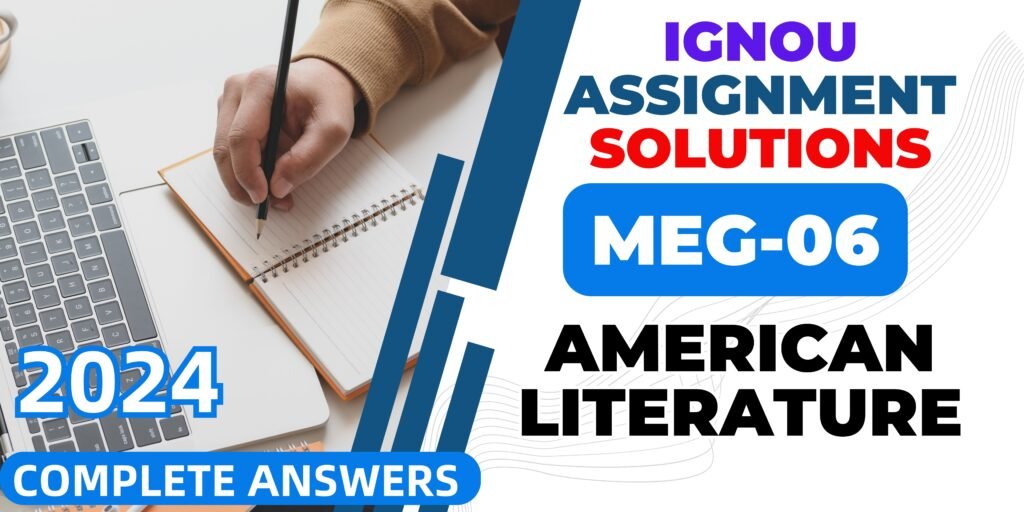IGNOU Assignment Question and Answers: MEG-06
MEG-06
AMERICAN LITERATURE
ASSIGNMENT 2023-24
(Based on Blocks 1-9)
Course Code: MEG-06/2023-24
Max. Marks: 100
Attempt all questions. All questions carry equal marks.
1. Discuss the material conditions and circumstances which made The American Enlightenment possible.
2. Discuss the use of human as a tool of social criticism in Huckleberry Finn.
3. Comment on the theme of Wallace Steven’s poem ‘The Emperor of Ice-cream’.
4. Discuss on the appropriateness of the title Toni Morrison’s novel The Bluest Eye.
5. Attempt a critical reading of A Clean Well Lighted Place.
Click Here to Download Assignment Questions
Answers
1. Discuss the material conditions and circumstances which made The American Enlightenment possible.
The American Enlightenment was a period of intellectual and cultural growth in colonial America during the 18th century. Several material conditions and circumstances contributed to the emergence of this movement, which was characterized by a focus on reason, science, and individual rights. In this essay, we will discuss these key factors that made the American Enlightenment possible.
- Colonial Economy and Trade:
One of the primary material conditions that fueled the American Enlightenment was the flourishing colonial economy and trade. The colonies were engaged in various economic activities such as agriculture, trade, and manufacturing, which contributed to the accumulation of wealth and resources. This economic prosperity provided individuals with the financial means to invest in education, literature, and scientific pursuits, fostering an environment conducive to intellectual growth. - Print Culture and Communication:
The rise of print culture played a crucial role in disseminating Enlightenment ideas throughout the colonies. The proliferation of newspapers, pamphlets, books, and journals enabled thinkers and writers to share their ideas, engage in debates, and reach a broader audience. Print culture facilitated the exchange of knowledge and facilitated the spread of Enlightenment values such as rationalism, skepticism, and liberty. - Educational Institutions:
The establishment and growth of educational institutions in the colonies were instrumental in promoting intellectual inquiry and critical thinking. Universities such as Harvard, Yale, Princeton, and William and Mary provided platforms for scholars and students to explore new ideas, conduct research, and engage in philosophical discourse. These institutions nurtured a generation of thinkers who would later contribute significantly to the American Enlightenment. - Influence of European Enlightenment:
The American Enlightenment was deeply influenced by the ideas and writings of European thinkers such as John Locke, Voltaire, Montesquieu, and Rousseau. Their works on natural rights, social contract theory, separation of powers, and religious tolerance resonated with American intellectuals, inspiring them to apply these principles to the colonial context. The transatlantic exchange of ideas facilitated by trade, travel, and correspondence contributed to the intellectual ferment of the era. - Political and Social Context:
The political and social context of colonial America also played a significant role in shaping the American Enlightenment. The colonies were undergoing a period of social change, with growing discontent over issues such as taxation without representation, religious freedom, and individual liberties. Intellectuals and activists seized upon these issues to challenge traditional authority structures and advocate for democratic ideals, leading to the development of revolutionary sentiments that would culminate in the American Revolution. - Philosophical and Scientific Advances:
Advances in philosophy, science, and mathematics during the Enlightenment period contributed to the intellectual climate that fostered the American Enlightenment. Thinkers like Isaac Newton, Francis Bacon, and René Descartes revolutionized the way people understood the natural world, promoting empirical observation, experimentation, and rational inquiry. These scientific and philosophical advancements encouraged a spirit of curiosity and exploration among American intellectuals, leading to innovative thinking and new perspectives on society, politics, and human nature.
In conclusion, the American Enlightenment was made possible by a confluence of material conditions and circumstances including economic prosperity, print culture, educational institutions, the influence of European Enlightenment ideas, the political and social context of colonial America, and philosophical and scientific advances. These factors created an environment conducive to intellectual exchange, critical thinking, and the development of Enlightenment ideals that would shape the course of American history.
2. Discuss the use of human as a tool of social criticism in Huckleberry Finn.
In Mark Twain’s “Adventures of Huckleberry Finn,” the character of Jim, an African American slave, serves as a powerful tool of social criticism. Through Jim’s experiences, interactions, and the challenges he faces, Twain critiques the institution of slavery, societal attitudes towards race, and the hypocrisy of moral values. In this essay, we will explore how Jim is utilized as a tool of social criticism in the novel.
- Depiction of Slavery:
Jim’s character provides readers with a vivid portrayal of the harsh realities of slavery in the pre-Civil War South. Twain exposes the dehumanizing effects of slavery through Jim’s experiences of being treated as property, separated from his family, and subjected to cruel and unjust treatment. Jim’s longing for freedom and his efforts to escape captivity highlight the inhumanity of a system that denies individuals their basic rights and dignity. - Critique of Racial Prejudice:
Through Jim’s interactions with other characters, Twain challenges prevalent racial prejudices and stereotypes. Despite being a kind-hearted and loyal companion to Huck, Jim is often viewed by society as inferior and unworthy of respect due to his race. Twain uses Jim’s character to confront the hypocrisy of a society that espouses notions of equality and freedom while simultaneously perpetuating racial discrimination and injustice. - Friendship and Humanity:
The friendship that develops between Huck and Jim serves as a central theme in the novel and a powerful commentary on human relationships. Despite the racial barriers and societal norms that seek to divide them, Huck and Jim form a deep bond based on mutual respect, empathy, and shared experiences. Twain emphasizes Jim’s humanity and moral integrity, challenging readers to question the arbitrary distinctions and prejudices that separate people based on race or social status. - Irony and Satire:
Twain employs irony and satire to critique the hypocrisy and moral contradictions prevalent in society. For example, the character of Miss Watson, who claims to be a devout Christian, owns slaves and sees no contradiction in her actions. Jim’s journey towards freedom, juxtaposed with the absurdity of societal norms and values, exposes the absurdity and injustice inherent in slavery and racial discrimination. - Symbolism of the Raft:
The raft symbolizes freedom and escape from societal constraints in the novel. Jim and Huck’s journey down the Mississippi River on the raft represents their quest for freedom, both literal and metaphorical. The raft becomes a sanctuary where Jim and Huck can be themselves, free from the judgments and prejudices of society. Twain uses the symbolism of the raft to underscore the theme of individual freedom and the desire to break free from oppressive social structures.
In conclusion, Jim’s character in “Adventures of Huckleberry Finn” serves as a powerful tool of social criticism, allowing Mark Twain to explore and critique issues such as slavery, racial prejudice, moral hypocrisy, and the quest for freedom. Through Jim’s experiences and interactions, Twain challenges readers to confront the injustices and contradictions of society while advocating for empathy, equality, and human dignity.
3. Comment on the theme of Wallace Steven’s poem ‘The Emperor of Ice-cream’.
“The Emperor of Ice-Cream” by Wallace Stevens is a thought-provoking poem that delves into themes of life, death, and the transient nature of human existence. Through vivid imagery and symbolic language, Stevens invites readers to contemplate the interplay between pleasure and mortality, challenging conventional notions of power and significance. In this commentary, we will explore the themes present in “The Emperor of Ice-Cream” and their significance within the poem.
- Life and Death:
One of the central themes of “The Emperor of Ice-Cream” is the juxtaposition of life and death. The poem opens with the scene of a wake or funeral, as indicated by the “old-maids” preparing the deceased for burial. However, the tone of the poem is not somber or mournful; instead, it embraces the vitality and richness of life. The mention of “wenches” and “boys” suggests a celebration of life even in the face of death, highlighting the cyclical nature of existence where moments of joy and pleasure coexist with moments of sorrow and loss. - Transience and Impermanence:
Stevens explores the theme of transience and impermanence throughout the poem. The image of the “Emperor of Ice-Cream” symbolizes the fleeting nature of human pleasures and earthly delights. Ice cream, typically associated with enjoyment and indulgence, becomes a metaphor for the temporary nature of life’s pleasures. The emphasis on the “concupiscent curds” and “dresser of deal” underscores the materiality and ephemerality of worldly pleasures, reminding readers of the inevitability of change and decay. - Symbolism and Allegory:
Stevens employs rich symbolism and allegorical elements to convey deeper meanings in the poem. The “wenches” and “boys” represent the vitality and exuberance of youth, while the “old-maids” and “portly” undertaker symbolize the inevitability of aging and mortality. The “dominion” mentioned in the final stanza alludes to the transient power and authority that humans hold in the face of the greater forces of nature and time. Through these symbols, Stevens invites readers to contemplate the larger philosophical questions surrounding life, death, and human existence. - Acceptance and Resilience:
Despite the themes of mortality and impermanence, “The Emperor of Ice-Cream” conveys a sense of acceptance and resilience. The poem’s tone is matter-of-fact and unflinching, suggesting a stoic acknowledgment of life’s realities. The emphasis on the practical preparations for the funeral, such as “the napkins” and “the waste,” contrasts with any sentimentality or romanticism, highlighting the pragmatic approach to dealing with death and loss. - The Power of Perception:
The poem also touches on the power of perception and interpretation. The title “Emperor of Ice-Cream” challenges traditional notions of grandeur and majesty, suggesting that significance and meaning are subjective and often arbitrary. Stevens prompts readers to question societal norms and conventions regarding power, status, and value, encouraging a more nuanced understanding of what truly matters in life.
In conclusion, “The Emperor of Ice-Cream” by Wallace Stevens explores themes of life, death, transience, and perception through rich imagery and symbolic language. The poem invites readers to reflect on the interplay between pleasure and mortality, challenging conventional ideas about power, significance, and the human experience. Stevens’ nuanced exploration of these themes makes “The Emperor of Ice-Cream” a compelling and thought-provoking work of poetry that continues to resonate with readers today.
4. Discuss on the appropriateness of the title Toni Morrison’s novel The Bluest Eye.
The title of Toni Morrison’s novel “The Bluest Eye” holds deep significance and contributes to the overall thematic exploration of the book. In this discussion, we will delve into the appropriateness of the title and its relevance to the themes, characters, and narrative structure of the novel.
- Symbolism of the Bluest Eye:
The title “The Bluest Eye” serves as a powerful symbol that encapsulates the central themes of the novel. The concept of the “bluest eye” represents an unattainable standard of beauty and perfection imposed by society, particularly concerning racial identity and physical appearance. The novel revolves around the character of Pecola Breedlove, a young African American girl who internalizes society’s ideals of beauty and yearns for blue eyes as a symbol of acceptance and worthiness. The title effectively captures the theme of self-perception, societal standards, and the destructive impact of Eurocentric beauty norms on individuals’ self-esteem and identity. - Critique of Racism and Colorism:
“The Bluest Eye” confronts issues of racism and colorism within African American communities and society at large. The title highlights the obsession with white standards of beauty, including light skin, straight hair, and blue eyes, which are often portrayed as superior and desirable. Morrison critiques the damaging effects of internalized racism and colorism, as seen through Pecola’s desire for blue eyes to escape her marginalized status and gain acceptance in a society that devalues blackness. - Perception vs. Reality:
The title also underscores the theme of perception versus reality throughout the novel. The “bluest eye” represents an illusionary ideal that contrasts sharply with the harsh realities faced by characters like Pecola, who experience discrimination, abuse, and neglect due to their race and socioeconomic status. Morrison challenges readers to question societal perceptions of beauty, happiness, and success, exposing the underlying prejudices and injustices that perpetuate inequality and oppression. - Complexity of Identity:
Another aspect of the title’s appropriateness lies in its exploration of the complexity of identity. The quest for the “bluest eye” reflects a deeper longing for validation, acceptance, and belonging in a world that marginalizes and devalues certain identities. Morrison delves into the layers of identity, including race, gender, class, and cultural heritage, highlighting the ways in which individuals navigate and negotiate their sense of self in the face of societal expectations and prejudices. - Narrative Structure and Symbolic Language:
The title’s appropriateness is further reinforced by Morrison’s use of narrative structure and symbolic language throughout the novel. The imagery of eyes, sight, and vision recurs symbolically, reflecting different perspectives, perceptions, and realities experienced by the characters. The title’s metaphorical significance extends beyond physical appearance to encompass deeper themes of perspective, insight, and the search for truth and authenticity amidst societal illusions and falsehoods.
In conclusion, the title “The Bluest Eye” is highly appropriate for Toni Morrison’s novel as it encapsulates key themes such as the quest for beauty and acceptance, the impact of racism and colorism, the complexity of identity, and the contrast between perception and reality. The title serves as a potent symbol that resonates throughout the narrative, inviting readers to critically examine societal norms, prejudices, and the complexities of human experience. Morrison’s masterful storytelling and thematic exploration make “The Bluest Eye” a profound and thought-provoking work that continues to provoke discussions about race, identity, and beauty standards.
5. Attempt a critical reading of A Clean Well Lighted Place.
“A Clean, Well-Lighted Place” by Ernest Hemingway is a brief yet profound story that delves into themes of existential despair, loneliness, and the search for meaning in a seemingly indifferent world. Through its minimalist style, sparse dialogue, and subtle characterization, the story invites readers to engage in a critical reading that explores deeper layers of human experience and emotional complexity.
- Existential Despair and Loneliness:
At its core, “A Clean, Well-Lighted Place” grapples with existential themes, particularly the sense of despair and loneliness that pervades the human condition. The older waiter, who represents experience and understanding, reflects upon the emptiness of life and the struggle to find solace in a world devoid of inherent meaning. The clean, well-lighted café becomes a refuge from the darkness and uncertainty that haunt the characters, highlighting their yearning for a sense of purpose and connection in an otherwise indifferent universe. - The Nihilistic Void:
Hemingway’s story subtly portrays a sense of nihilism, where characters confront the absence of transcendent values or ultimate truths. The old man’s attempted suicide and the younger waiter’s dismissive attitude towards his despair underscore the existential void that threatens to engulf individuals when faced with the harsh realities of existence. The clean, well-lighted café serves as a metaphorical sanctuary where individuals seek temporary respite from the abyss of meaninglessness. - Aestheticism and Escapism:
The café itself takes on symbolic significance as a space of aesthetic pleasure and escapism. The emphasis on cleanliness, orderliness, and well-lit surroundings contrasts with the chaos and darkness of the outside world, suggesting a desire for sensory comfort and psychological refuge. The characters’ ritualistic behavior within the café, such as the old man’s insistence on cleanliness and the waiter’s meticulous attention to detail, reflects their attempts to create a semblance of order and control in a chaotic and unpredictable world. - The Absurdity of Life:
Hemingway’s story touches upon themes of absurdity, highlighting the incongruity between human aspirations for meaning and the inherent randomness and unpredictability of existence. The old man’s despair, stemming from a sense of irrelevance and insignificance, mirrors the existential angst experienced by individuals grappling with the absurdity of life’s circumstances. The younger waiter’s impatience and indifference further underscore the disconnect between human longing for significance and the indifferent cosmos. - The Role of Empathy and Understanding:
Amidst the bleakness of existential despair, “A Clean, Well-Lighted Place” also explores the significance of empathy, compassion, and understanding in alleviating human suffering. The older waiter’s empathy towards the old man’s need for a clean, well-lighted environment reflects a deeper understanding of the human condition and the importance of small comforts in mitigating existential angst. The contrast between the older waiter’s empathy and the younger waiter’s callousness highlights the capacity for human connection to provide solace in the face of despair.
In conclusion, “A Clean, Well-Lighted Place” offers a rich terrain for critical reading, inviting readers to explore themes of existential despair, loneliness, nihilism, aestheticism, and the absurdity of life. Hemingway’s minimalist style and nuanced characterization create a hauntingly evocative narrative that resonates with universal questions about human existence and the search for meaning in a world that often seems indifferent to our struggles and aspirations.



